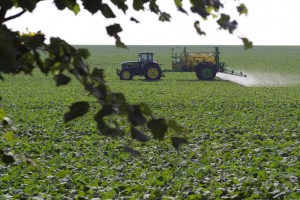
More evidence that low-calorie sweeteners are bad for your health
Studies show that artificial sweeteners can raise the risk of hypertension, metabolic syndrome, type 2 diabetes and heart disease, including stroke.

Natural Health News — Pesticides are a bigger problem throughout Europe than had long been assumed.
This is the conclusion of a study in the journal Science of the Total Environment, in which scientists analysed data on 500 man-made substances in the basins of four major European rivers. The study found that 38% of these chemicals are present in concentrations which could potentially have an effect on organisms.
Most of the substances classified as a risk to the environment in the study were pesticides and, worryingly, the majority of these are not on the European list of priority substances which have to be monitored regularly.
The cumulative effects of exposure to these waterborne pollutants – singly and in combination – on health is unknown. Many pesticides accumulate in the body and are known to be neurotoxic and hormone-disrupting.
The study focused on organic pollutants recorded in over 750,000 individual analyses of water in the basins of the Elbe (Czech Republic/Germany), the Danube (10 neighbouring European countries), the Schelde (Belgium) and the Llobregat (Spain) rivers.
One of the most frequently registered compounds was diethylhexyl phthalate (DEHP), a chemically-produced softener used in plastics manufacture which may impair fertility and is therefore banned in the EU from 2015. This is followed by another softener bisphenol A (BPA), which may also impair fertility, and diclofenac and ibuprofen, two pharmaceutical substances used commonly in painkillers.
Scientists from the Helmholtz Centre for Environmental Research (UFZ) together with colleagues in France, Slovakia, Belgium and Spain, classified a total of 73 compounds as potential priority pollutants. Around two thirds of these are pesticides. The most problematic amongst these were diazinon, which is already no longer allowed in Germany and Austria, as well as azoxystrobin and terbuthylazine, which are still allowed in Central Europe.
None of these pesticides is on the list of 33 priority pollutants which have to be regularly monitored by authorities throughout the EU under the terms of the European Water Framework Directive – the aim of which is to ensure that surface water and groundwater bodies should reach a good environmental and chemical status by 2015.
Indeed, say the scientists, the majority of the substances currently presenting problems are not on the list, while many of the chemicals being monitored have been banned for some time and are no longer used.
Under the auspices of the Directive, the chemical status of European waterbodies is assessed based on a list of 33 so-called priority pollutants. As over 14 million chemicals are on the market and over 100,000 of these are produced on an industrial scale, the authorities say they have to confine their monitoring to a manageable number of pollutants. Throughout Europe scientists are therefore working on methods to establish which pollutants these should be.
However, on the basis of this new data, the scientists stressed the urgency of revising the list of priority chemicals specified by the Directive.
“We were also surprised that substances previously classified as harmless, such as HHCB, which is used as a synthetic musk fragrance in personal care products, are present in the environment in alarming concentrations,” says Dr. Werner Brack of the UFZ, who advises the European Commission in various committees and projects on the revision of the list of priority pollutants.
“In our opinion the development of the Water Framework Directive should ensure that in future not only the presence of chemical substances but also their effects are monitored”.

Please subscribe me to your newsletter mailing list. I have read the
privacy statement